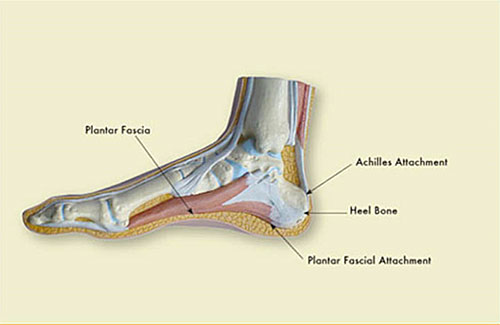What is Sever's Disease?

Sever’s disease or Sever’s lesion refers to an injury to the bone growth plate at the back of the heel bone (calcaneous) in young people, particularly those who are physically active. It usually develops in puberty and is slightly more common in boys than girls.
How does Sever's Disease happen?
The large calf muscles attach to the heel via a large tendon called the Achilles tendon.
The function of this tendon is to transmit forces produced by the calf muscles to the heel bone. In children, the portion of the heel bone into which the Achilles tendon inserts is separated from the bulk of the heel bone by a growth plate. This growth plate enables bone growth to occur. However, it also represents a site of weakness in the bone. Forcible and repeated contraction of the calf muscles can injure the growth plate. This commonly occurs during a period of rapid growth where the muscles and tendons become tighter as the bones grow. This leads to increased pulling of the calf muscles and Achilles tendon on the heel bone and growth plate.
How does it feel to have Sever's disease?
The pain is at the heel or around the Achilles tendon. This is felt commonly during exercise, particularly activities involving running or jumping. The back of the heel may also be tender to touch and there may be localised swelling. There may be stiffness in the calf muscles first thing in the morning and you may notice limping or a tendency to tiptoe.
Contributing factors to Sever's disease
Apart from the age of the young person, other factors that may contribute to developing the disease may include; overuse or too much physical activity. Your child’s heel pain may be caused by repeated stress on the heels (running and jumping activities), pressure on the back of the heel from too much standing or wearing poor-fitting shoes. This includes shoes that do not support or provide enough padding for your child’s feet.
What should you do if you have Sever's disease?
If you suspect your child has Sever’s disease you should seek assistance from your podiatrist. In the meantime you should limit their participation in sporting activities to restrict the amount of damage to the growth plate.
What shouldn’t you do if you have Sever's disease?
You should not exercise or exercise through pain as this could cause further damage.
Management of Sever's disease
Your podiatrist will assist in diagnosing the injury and the extent of the damage. From this, they will develop a management plan which may include rest or activity modification, soft tissue treatment such as massage and stretching, correction of biomechanics through heel raises or orthoses and the progression through a series of specific strengthening exercises.
Want specific advice for your individual situation?
Make an appointment today on (07) 3846 4800.
Suite 2B, 90 Vulture Street, West End, Queensland 4101
© 2009- Performance Podiatry and Physiotherapy Brisbane | Privacy Policy | Disclaimer | Website design:
